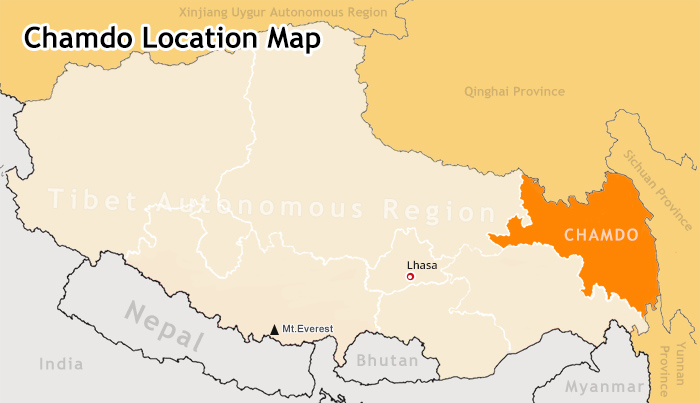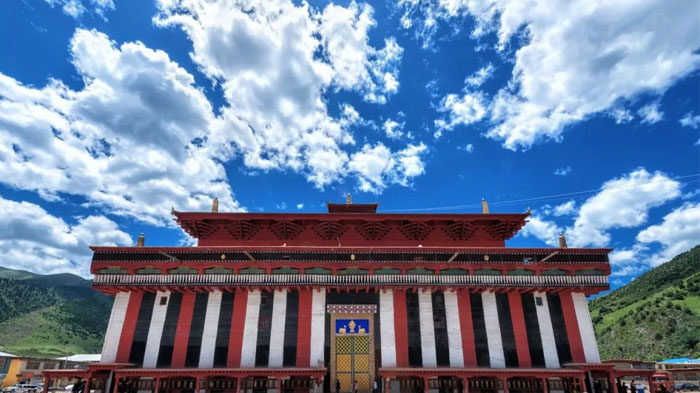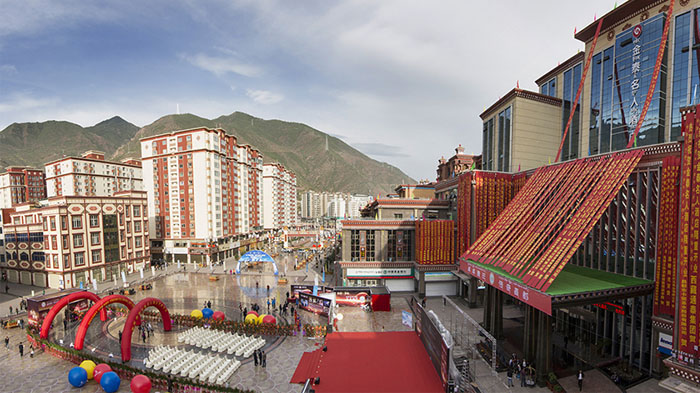
Chamdo Kham: a major transportation hub of ancient tea horse road to Tibet
Chamdo, often referred to as Qamdo, is one of the major centers of the Tea Horse Road that once ran from China across the plateau to India. A major junction along the Tea Horse Road, Chamdo was the connecting point for the caravans from Chengdu in Sichuan Province and Pu’er in Yunnan Province. From there, the caravans would head west along the tea Horse Road into Tibet to Lhasa, and then on across the borders to northeast India.
Now one of the seven prefectures of the Tibet Autonomous Region (TAR), Chamdo is one of the least visited areas of Tibet by international tourists, mostly due to its more remote location. However, the northern route of the Sichuan Tibet Highway runs straight through Chamdo, along the route of the Tea Horse Road, and has opened up the area a little to tourism.
Where is Qamdo Tibet?
Chamdo lays in the southeast of the Tibet Autonomous Region, with Nyingchi to the south, Sichuan to the east, northern Yunnan to the far southeast, Qinghai to the north, Lhasa to the west, and Nagqu Prefecture to the northwest. Lying on the lower levels of the plateau, Chamdo lies around 600 kilometers to the east of Lhasa, though by road it is more than a thousand kilometers to the Tibetan capital. Located at the confluence of the Za Chu and Ngom Chu Rivers, it is the formation point of the Lancang River, which later becomes the mighty Mekong River.
 (Simple click to enlarge the map)
(Simple click to enlarge the map)
Qamdo Location Map
Top Tourist Attractions in Chamdo Prefecture
Galden Jampaling Monastery
Once visited by the great Je Tsongkhapa, Chamdo is the site of the Galden Jampaling Monastery, which was built in the middle of the 15th century by one of the Tsongkhapa’s disciples. Known as the Changbalin or Qiangbalin Si Monastery, the monastery once contained five huge temples and more than 3,000 monks. After being destroyed and then rebuilt in the early part of the 20th century, the monastery now houses around 800 monks, and is one of the major monasteries of the Gelug School of Tibetan Buddhism.
Ranwu Lake (Rawok-tso)
Located in the southwest of Baxoi County in Chamdo, Ranwu Lake is a popular stopping point for travelers on the Sichuan Tibet Highway. A barrier lake that was formed from natural landslides that blocked the original river, the lake is fed by snow melt from the surrounding mountains and glaciers, and runs out on the western side into the Parlung Zangbo River, a major tributary of the great Yarlung Tsangpo River. A freshwater lake, Ranwu freezes over in the winter, and has a beautiful blue color in the summer months.
Lhegu Glacier
A group of glaciers that lie close to the village of Lhegu at the foot of the Bosura Mountain, this charming glacial formation is renowned for its black and white medial moraines, and consists of six separate glaciers - Meixi Glacier, Yalong Galcier, Ruojiao Glacier, Dongga Glacier, Xiongjia Glacier and Niuma Glacier - which surround the village.
Riwoqe Monastery (Riwoche Tsuglhakhang)
A huge monastery that towers over the small Riwoqe Town, Riwoqe Monastery was founded in the 13th century as an offshoot of the Talung Monastery, which grew to overshadow the parent monastery over the centuries. Now rated as one of the most impressive monasteries in Tibet, it still retains its characteristic colors of red, white, and black, and is home to around 500 Talung Monks.
 Founded in 1276, Riwoqe Monastery is one of the biggest monasteries in Chamdo.
Founded in 1276, Riwoqe Monastery is one of the biggest monasteries in Chamdo.
Kamaduo Stupas
Located on the north line of the Ancient Tea Horse Road, the Kamaduo Stupas were built in the 7th century, and the area was originally known as Baxag. According to the ancient records, more than 130 stupas existed at the time of their construction, many of which were destroyed over the centuries. Years later, several were rebuilt, including the Pagoda of Eight Buddhas, the Square Pagoda, and many others. Behind the pagodas lies a huge mound of Mani Stones, which are said to have been laid on the site more than 1,300 years ago.
Wara Monastery
One of the main monasteriesof the Sakya School of Tibetan Buddhism, Wara Monastery is located in Jomda County and is famed for the peacocks that live there all year round, an auspicious bird in Tibetan Buddhism. The first large man-made landmark you will see after entering Tibet from Sichuan Province, the monastery holds around 200 monks. Once a major monastery of the White Bon, the monastery was taken over by the Sakya School in the 12th century and is currently the largest Buddhist College of the Sakya Sect in Tibet.
Kanuo Ruins (Karub Ruins)
The earliest remains of civilization found in Tibet, the Karub Ruins are located about 12 kilometers southeast of Chamdo county seat, and cover an area of around 10,000 square meters. Lying at an altitude of around 3,100 meters on the side of the Lancang River, it is believed that the remains of the settlement found by archaeologists dates back to around 2,200 BC. The site has yielded all kinds of stone and bone tools that suggest there was a primitive village on the site, complete with stone walls, stone-built houses, and surrounding pathways.
Zezhol Monastery
One of the most well-preserved Bon monasteries in Tibet, the Zezhol Monastery is located around 37 kilometers inside Deqen County and has the most complete collection of the Bon traditions in the world. Lying on one of the four Sacred Mountains of Bon, Mount Zezhol, the monastery dates back more than 3,000 years, and has seen the rise of more than 80 of the great Bon Masters.
Banda Grassland
With an average altitude of more than 4,000 meters, the Banda Grassland is a wide and beautiful wilderness of grassy plain, without a tree in sight, which stretches for miles across the Chamdo area. Yaks and sheep can be seen everywhere on the grasslands, which are the home to many nomadic herders throughout the year.
How to Get to Chamdo Tibet
There are two ways to get to Chamdo in Tibet, by flight and by driving. The Chamdo Bamda Airport, which is located on the western bank of the Yuqu River in one of the valleys of the Banda grasslands, is only served by flights from Chengdu, Lhasa, Chongqing, and Tianjin, and offers domestic flights from Air China and Tibet Airlines. However, this airport is only open to domestic tourists, so the only way in is to drive for international tourists.
 (Simple click to enlarge the map)
(Simple click to enlarge the map)
Sichuan Tibet Highway Map
Driving is the best option, anyway, as you get to see the stunning views along the Sichuan Tibet Highway, whether you start in Chengdu or in Lhasa. Driving from Lhasa can be done by using either the G317 northern route (1,068km) or the G318 southern route (1,112km), and takes between 22 and 23 hours of constant driving to reach. The easiest route is the G318 Southern Route of the Sichuan Tibet Highway, as it is the better road, which follows the route of the G318 to Bangdazhen, where it turns north to take the G214 to Chamdo and Karuo District.
How to Plan an Eastern Tibet Tour from Lhasa to Chamdo
If you are planning to visit Chamdo, then we have the perfect tour for you. Starting in the Tibetan capital of Lhasa, our 15-day tour of Eastern Tibet is the ideal way to visit this hardly-seen region of Tibet, lying on the lower regions of the Tibetan plateau. The tour starts in Lhasa, with a tour of the ancient city including the Jokhang Temple and the Potala Palace, before heading out to visit parts of Nyingchi, to the east of Lhasa. The tour takes you through Nyingchi, passing such sights as the beautiful Basomtso Lake, and heading all the way through Markam to Litang, the location of the famous Litang Grasslands. Then it is on up to Derge and Chamdo, along the Sichuan Tibet Highway. Derge is the heartland of the ancient Kham Region of Tibet, with many important monasteries. A journey of more than 1,200 kilometers, this amazing and epic adventure will give you insights into the ancient Kham culture of Chamdo like no other.
Best Time to Visit Chamdo
With its lower elevation, Chamdo is a place that can be visited throughout the year. However, it can get cold in the winter months, due to the vast mountain ranges in the area. For most travelers, it is best visited from May to October, when the Chamdo weather is at its best. June to mid-September is the monsoon season in Chamdo, and while there is rain in the region, it is not as heavy as it falls in Nyingchi to the south. A cooler and drier climate, Chamdo has less than 100mm of rain throughout the wettest month of July, and the skies are clear and bright for most of the year.
Hotels and Accommodations in Qamdo Prefecture
The Jintai Hotel at the southern end of the Changjin Bridge in Macaoba is a very good quality 3-star hotel that is a family run business. With Wi-Fi available throughout the hotel and en-suite bathroom in all of the rooms, this traditionally-styled hotel is close to the river and has good views over the town. All en-suite rooms come with both bath and shower facilities, and have western-style toilets instead of the usual Chinese squat toilets that would be expected in the hinterlands of Tibet.
 Chamdo Jintai Hotel is one of the best hotels for you to stay while visiting Kham area.
Chamdo Jintai Hotel is one of the best hotels for you to stay while visiting Kham area.
The Qamdo Hotel on Changdu West Road in Qamdo County is a relatively good 3-star hotel with a great number of good reviews. Located just 65km from the Bangda Airport, this quaint little hotel has all the amenities you could wish for, including Wi-Fi, en-suite bathrooms, and bunk rooms for those traveling on a budget. The main lobby has some excellent Tibetan murals as decorations, and the rooms are clean and tidy with free drinking water for all guests. Service at the hotel is good and the small internal restaurant has a good range of Tibetan and Sichuan dishes on offer.
The Changdu Grand Conference Center Hotel on Changdu Road is a three-star hotel that is set in a clean and friendly neighborhood, and the rooms all include a humidifier to help with the extremely dry air of the region. The hotel is a lively and friendly hotel with a lot of functions that go on throughout the main tourist season, including local dance performances in the square on the ground floor. Services and conditions are well above average for the area, and the hotel combines accommodation with meeting rooms and two separate dining rooms serving Tibetan, Sichuan, and some western dishes.
Travel Permits for Tibet Chamdo Tour
For anyone traveling to Chamdo, there are certain permits that you will need in order to get there, whether you are traveling from Chengdu or from Lhasa. The main permit is the Tibet Travel Permit, which is required for all travelers that are entering Tibet. The permit is required for getting into the region and traveling in the area of Lhasa, and can take around 15 days to process.
You will also need the Alien’s Travel Permit, which is required for travelers journeying out of Lhasa to the “unopened” areas of Tibet, of which Chamdo is one. The permit is applied for in Lhasa for those entering Chamdo from the capital, or by your tour operator before traveling for those entering from Chengdu.
You will also need the Restricted Areas Permit, also known as the Military Permit, as the area of Chamdo is classed as a restricted zone in China. The permit is applied for through the Public Security Bureau in Lhasa or Chengdu, depending on which side you are coming from, and can take up to 2 weeks to process.
Conclusion
Chamdo is one of the least visited areas of Tibet, but has some of the most amazing sights and experiences on the plateau. An ancient land of the Khampa peoples, there is nowhere on the planet like Chamdo, and it is one place in Tibet where you will be able to completely lose yourself in the unique Khampa culture and the stunning natural landscapes.

The Lhasa-born prodigy used to study business overseas, and got his Bachelor of Business in Nepal and India before moving back to his homeland. With pure passion for life and unlimited love for Tibet, Kunga started his guide career as early as 1997.
Responsible, considerate, and humorous, he devoted his entire life to guiding and serving international tourists traveling in Tibet. As a legendary Tibetan travel guru with 20-year pro guide experience. Currently, he is working in Tibet Vista as the Tour Operating Director. Whenever our clients run into trouble, he is your first call and will offer prompt support.


.jpg)


0 Comment ON "Chamdo Kham: a major transportation hub of ancient tea horse road to Tibet"